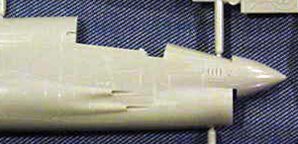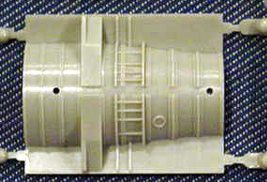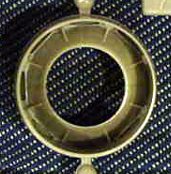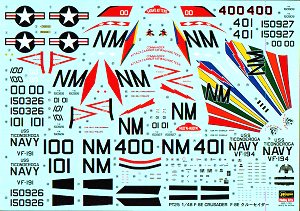
|
KIT: |
Hasegawa 1/48 F-8E Crusader |
|
KIT # |
7225 |
|
PRICE: |
¥3200 ($41.00 MSRP in the US) |
|
DECALS: |
Four Aircraft |
|
REVIEWER: |
|
|
NOTES: |
Big box; big decal sheet |

|
HISTORY |
Although Chance-Vought prop aircraft like the F4U Corsair were considered legendary, they had less success with their first jets. Both the F6U and F7U were marred by rather poor performance of early jet engines and radical concepts that seemed to be too advanced for the equipment of the day. But that forward-thinking attitude of Chance-Vought’s designers and more mature equipment paid off with the introduction of the F-8 (pre-1962 designation “F8U”) Crusader. The wing was mounted high on the fuselage, to help keep the undercarriage length short and sturdy. To achieve good slow speed performance for carrier operations, the plane was given a variable incidence wing. The wing can be raised in flight, while the fuselage of the plane stays level, giving benefits of better slow speed flight without sacrificing pilot visibility.
The aircraft was designed as a single seat day fighter/interceptor, armed with four 20mm cannons and Sidewinder missiles. Early Crusaders also featured a common 1950s fighter armament of 2.75 inch rockets mounted in a retractable belly tray. The gun armament earned it the nickname “Last of the Gunfighters” as other fighters on the drawing board at that time were favoring missile armament entirely for the fighter role. The Crusader’s eventual replacement, the F-4 Phantom didn’t have an internal gun at all in its Naval versions and a Navy fighter design didn’t come equipped with a standard cannon until the F-14 Tomcat entered service. The gun armament helped the Crusader to earn 18 kills in the Vietnam War. Although for one of the kills, the Mig driver ejected without the Crusader pilot even firing a round. Later Crusaders had their Sidewinder capability doubled from two missiles to four with the help of a “Y” shaped missile rack.
The Crusader achieved many firsts in service at a time when the Air Force was getting most of the glory. Powered by the Westinghouse J57 afterburning turbojet, the Crusader prototype flew on March 25. 1955 and went supersonic on its first flight. It was the first production aircraft to set an official record of flying over 1000 miles per hour in level flight. The Crusader in its RF-8 guise also set an official record for a transcontinental crossing of the U.S. with Major John Glenn (future Mercury astronaut) at the controls. The plane also became the first Navy aircraft to fly (albeit accidentally) and land with its wings FOLDED!
Pilots loved its performance, but it was also a demanding fighter to fly, especially in a dogfight. The lack of a two seat trainer (only one built late in the program) meant that Crusader pilots were some of the most experience fliers that the Navy had at the time as they had to learn to fly their planes solo from day one. The planes stayed in operational service even when the F-4 Phantom became the prime fighter for the Navy as the heavier plane couldn’t operate from the decks of smaller Essex class carriers. The U.S. Navy Crusader fighter variants were retired when the last Essex class ship was retired in 1976. But the RF-8 recon Crusader stayed in operation until the last one was retired in 1987. The French Navy operated Crusaders from their even smaller aircraft carriers since 1964 and only just retired their last aircraft a few years ago to transition to the Rafale M. The Philippines also purchased several rebuilt Crusaders in 1977.
The F-8E Crusader was the last of the original build fighters for the U.S. Navy. The AN/APQ-94 radar was larger then the units carried on earlier variants, resulting in a more bulged radome with a longer length. Provisions were made to give the F-8E ground attack capability in the form of under-wing weapons pylons. A fairing was also added to the top of the wing for avionics associated with guiding the Bullpup ASM. The F-8E had a more powerful engine then previous variants, but it was also heavier and performance suffered a little as a result. The F-8E claimed 11 of the 18 Mig kills made by Crusaders in Vietnam and performed numerous ground attack sorties. Many F-8Es were remanufactured in the late 60s with features from the French Crusaders, such as larger tailplanes, double-hinged leading edge droops were also fitted to the wing.
|
THE KIT |
 I’ve
been chomping at the bit to get my hands on the new Crusader when Hasegawa first
announced it late last year. I think Hobbylink Japan might have set a shipping
record in the process as the kit only took five days to arrive on my doorstep
from the time they announced that it shipped. First thing that surprised me
about this kit is the size of the box. This box is about mid-way in size between
the large boxes Hasegawa uses for their F-4 and F-15 kits and the small ones
they use for most everything else in 1/48.
I’ve
been chomping at the bit to get my hands on the new Crusader when Hasegawa first
announced it late last year. I think Hobbylink Japan might have set a shipping
record in the process as the kit only took five days to arrive on my doorstep
from the time they announced that it shipped. First thing that surprised me
about this kit is the size of the box. This box is about mid-way in size between
the large boxes Hasegawa uses for their F-4 and F-15 kits and the small ones
they use for most everything else in 1/48.
The kit comes molded in 119 parts, with the majority being in gray plastic. Clear parts are separately bagged and the kit also contains something you’d be more likely to find in a Gundam kit, poly-caps (I’ll explain why later). Parts are typical Hasegawa quality with petite recessed panel lines and crisp molding with no noticeable flash present. Detailing looks accurate based on the references I have. The wing parts trees suggest that other variants are planned, such as the French F-8E (FN) and F-8J with the larger tailplanes and double droops, as there empty spaces in the parts tree for these future parts. I don’t see any obvious nose mold swap out though, so it will be interesting to see how Hasegawa will pull off an earlier F-8 with the slimmer radome.
 The
cockpit detailing is made up of fine raised lines for the instruments, but
decals can be used also. The ejection seat is a multiple piece affair that looks
accurate, but a few modelers will probably stick a resin seat in if they desire
it. A multi-piece pilot figure is also provided. The leading edge of the intake
lip is molded with the fuselage halves and a two-part (horizontally split)
intake housing sits mid-way down the nose. Filling the seams here might be
tricky. But based on past experience, even if this intake was built with only
the fuselage seam addressed, you probably won’t see the join seam to the intake
housing unless somebody sticks a penlight up there (standard IPMS judging
equipment). The nose gear bay is molded to the bottom half of the intake
housing. The gear bays look reasonably busy, but more stuff could be added if a
modeler desires. The gear struts are nicely detailed, but it is hard to tell if
this model will suffer from the same stance problem as the Monogram kit, as the
Hasegawa main gear struts are molded in multiple pieces (I don’t think it will
though). There has been some concern expressed over the nose gear strut possibly
looking like a beefed up strut that was only found on rebuilt Crusaders. I can’t
really tell if this is the case personally, so I’ll leave it up to you to decide
if this is so. BTW, for those of you that really didn’t like the nose wheel
molded to the strut on the A-4 kit, the Crusader has a separate nose wheel.
The
cockpit detailing is made up of fine raised lines for the instruments, but
decals can be used also. The ejection seat is a multiple piece affair that looks
accurate, but a few modelers will probably stick a resin seat in if they desire
it. A multi-piece pilot figure is also provided. The leading edge of the intake
lip is molded with the fuselage halves and a two-part (horizontally split)
intake housing sits mid-way down the nose. Filling the seams here might be
tricky. But based on past experience, even if this intake was built with only
the fuselage seam addressed, you probably won’t see the join seam to the intake
housing unless somebody sticks a penlight up there (standard IPMS judging
equipment). The nose gear bay is molded to the bottom half of the intake
housing. The gear bays look reasonably busy, but more stuff could be added if a
modeler desires. The gear struts are nicely detailed, but it is hard to tell if
this model will suffer from the same stance problem as the Monogram kit, as the
Hasegawa main gear struts are molded in multiple pieces (I don’t think it will
though). There has been some concern expressed over the nose gear strut possibly
looking like a beefed up strut that was only found on rebuilt Crusaders. I can’t
really tell if this is the case personally, so I’ll leave it up to you to decide
if this is so. BTW, for those of you that really didn’t like the nose wheel
molded to the strut on the A-4 kit, the Crusader has a separate nose wheel.
The wings are molded with the wingtips down, so you’ll have to do some kit surgery or wait for the resin aftermarket to fold the wings. In my opinion, this is better as the Monogram kit had some bad seams resulting from its separate wingtips anyway. But, the flaps and droops are molded separately, allowing the wing to be built in clean or dirty configuration. There is also a clever feature Hasegawa added involving the variable incidence wing. Remember the poly-caps? Well thanks to these vinyl wonders, you don’t have to glue the wing on and can change its position very easily at a later date, simply by sliding in the wing raising mechanism. Once the wing is on, you can turn the plane upside-down and not worry about the wing falling off, yet taking the wing off to change it back is still a breeze. The only drawback to this is that most pictures I’ve seen of raised Crusader wings show them with the flaps and droops lowered and I’ve seen no pictures of a Crusader with lowered surfaces on a lowered wing. But still the poly-caps are a nice feature and I suppose if a modeler wanted to, he could get two Crusader kits and build both a raised and a lowered wing, then swap wings as desired (assuming that the wings are painted with exactly the same markings).
 Other
parts in the kit look good. The J57 engine rear end is very nicely done and
should be a joy to build and weather. The holes and pegs for the horizontal
stabilizers are circular, so they can be placed in any position the modeler
wants. Weapons pylons are provided in the form of Sidewinder “Y” rails and
single pylons for the wings. Eight LAU-7 Zuni rockets are provided in twin tube
configuration as the only ordnance option in this kit. If you want Sidewinders
or bombs, you’ll have to raid other kits or get the Hasegawa weapons sets
(annoying, but not unexpected).
Other
parts in the kit look good. The J57 engine rear end is very nicely done and
should be a joy to build and weather. The holes and pegs for the horizontal
stabilizers are circular, so they can be placed in any position the modeler
wants. Weapons pylons are provided in the form of Sidewinder “Y” rails and
single pylons for the wings. Eight LAU-7 Zuni rockets are provided in twin tube
configuration as the only ordnance option in this kit. If you want Sidewinders
or bombs, you’ll have to raid other kits or get the Hasegawa weapons sets
(annoying, but not unexpected).
There is one problem with the kit that I am aware of. The two-piece canopy as it is can only be built in the lowered position without some modifications. The canopy hinge “thumbs” appear to sit in their proper position on the canopy, but they need to be a little fatter and longer for the cockpit to open and the corresponding holes in the fuselage opened up a little wider. I’ve seen some internet posters really blast the kit because of this. But to me, it’s only a minor concern and the fix should be easy to accomplish with a little strip styrene and some cutting and sanding. The work needed should only take about an hour to do. Maybe I’ll feel different about this feature after I do this to my model, but I doubt it.
|
DECALS |
 Markings
are provided for four very colorful aircraft. You get markings for a pair of CAG
birds from squadrons VF-191 “Satan’s Kittens” and VF-194 “Red Lightnings” of
CVW-19, U.S.S. Ticonderoga. Markings for the squadron commander birds of these
squadrons are also provided. The markings look very clean, colorful and are in
register (typical Hasegawa quality). Extensive stenciling is also provided, even
for the gear bays! I don’t think any aftermarket stenciling sheets will be
needed here, just markings for other squadrons (of which many sheets are already
available) if you don’t want to use the kit choices. I would recommend perhaps
photocopying the intake warning stripe decals and using it as a masking template
for the nose though, as the white backing isn’t provided and will need to be
painted.
Markings
are provided for four very colorful aircraft. You get markings for a pair of CAG
birds from squadrons VF-191 “Satan’s Kittens” and VF-194 “Red Lightnings” of
CVW-19, U.S.S. Ticonderoga. Markings for the squadron commander birds of these
squadrons are also provided. The markings look very clean, colorful and are in
register (typical Hasegawa quality). Extensive stenciling is also provided, even
for the gear bays! I don’t think any aftermarket stenciling sheets will be
needed here, just markings for other squadrons (of which many sheets are already
available) if you don’t want to use the kit choices. I would recommend perhaps
photocopying the intake warning stripe decals and using it as a masking template
for the nose though, as the white backing isn’t provided and will need to be
painted.
|
CONCLUSIONS |
In the box, the “Last of the Gunfighters” looks like a good investment. I don’t see any obvious problems (except for the canopy) and it should build as well as advertised. I’m sure Black Box and Cutting Edge will be more then happy to provide aftermarket extras in the form of cockpits, ejection seats and wing fold mechanisms. But, a good quality out of the box build should most definitely be possible with this kit, except for lack of ordnance. I paid about $26.60 for my Crusader (plus shipping) from HLJ and I’d expect the U.S. prices to be only slightly higher once they reach U.S. shores. Hopefully, other versions should be available soon as well. Based on what I see, it looks like a winner.
Jay got his kit quickly from HobbyLink Japan.
If you would like your product reviewed fairly and quickly by a site that has well over 175,000 visitors a month, please contact me or see other details in the Note to Contributors.